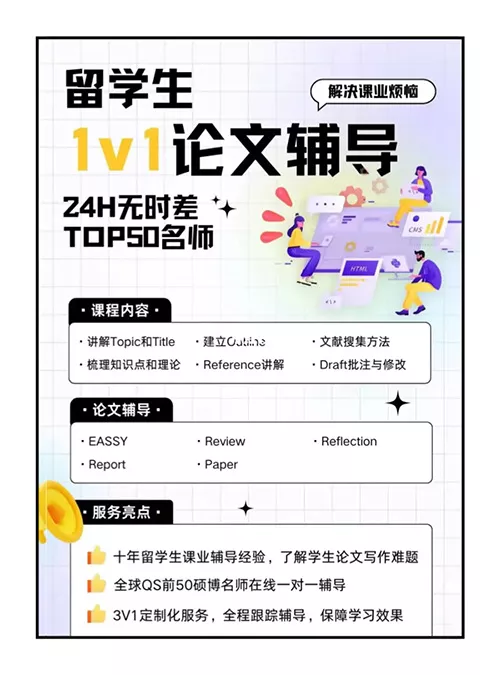Essay格式之一-文字格式
1.字体:timesnewroman,字号:小四,行距:1.5倍。写作前请调整这些格式,以免写完后出现意想不到的情况。
2.段落间隔。每段不需要像中文写作那样空两格,而是直接顶格写。
Essay格式二-整体结构
Essay的写作通常只包括三个部分:Introduction(介绍/开头)、Mainbody(主要部分)、Conclusion(结论/结尾)。
Introduction包括topic的背景介绍和文章要解决的主要问题。一般占总字数的10%左右。
Mainbody是主要部分,约占总字数的80%。如果题目中有具体要求,可以根据题目中提到的几个方面逐一讨论。有些问题是根据自己的想法写的,没有具体要求。但要求是合乎逻辑的。
Conclusion(结论/结尾)也占10%,本段用一两句话总结文章的主要观点。
Essay不能写题目,不能加粗小标题。
Essay格式之三-reference是最重要的
出国留学的童鞋都知道Essay 一般需要引用 reference。reference 是老师最看重的,请注意。所以请认真听童鞋!
1.不管前一页主体部分最后一页剩下多少空间,reference 都要另一页写。
2.每个reference 之间应该有一条空线。如果一个reference 一排写不完,下面几排的提行应该和第一排的三格一起进行。请参考我发的 referencing的要求。
3.References的排列应按字母顺序排列。网站的 reference 可以放在最后。
4.H引用分为直接引用和间接引用。直接引用是使用文章或书中的原文。请在作者背后以(年龄、页码)的形式进行标记。没有作者在引用的句子后面以(作者名称、年龄、页码)的形式进行标记。间接引用是指文章或书中的观点。引用方法与直接引用形式相同,但无需标记页码。
简而言之,referencesg绝对不能编造,必须是真实的。教授对这个问题进行了严格的调查。一旦发现欺诈或剽窃,合作伙伴很可能面临被解雇的严重后果。
要做的 reference 有两种,一种是in-text reference,即文章中的reference,另一种是文章末尾出现的 reference,即 referencelist。写一篇论文,两种 reference 都会出现,也就是说完成 in-text rerence后,还要做最后的reference list。如果你不清楚reference list该怎么写的话,可以参考这篇管理专业的 Reference List写作范例:
---
Abramson, N.R. (2007) The Leadership Archetype: A Jungian Analysis of Similarities between Modern Leadership Theory and the Abraham Myth in the Judaic-Christian Tradition. Journal of Business Ethics, Vol. 72: 115-129.
Anantatmula, Vittal S. (2010) Project Manager Leadership role in improving project performance. Engineering management journal (March 2010) Vol 22 No. 1
Babbie and Earl (1990), Survey research methods, Wadesworth Publishing Company, California.
Bass, B. M. (1981) Stodgill’s handbook of leadership: A survey of theory and research. New York: Free Press.
Blaxter, L. and Hughes, C. (2001) How to research, Open University Press. Buckingham.
Dainty, Andrew R. J., Cheng, Mei-I and Moore, David R. (2004) A competency-based performance model for construction project managers. Construction management and economics (October 2004) 22, 877-886
Djebarni, R., (1993) "Leadership patterns in the construction industry in Algeria", Unpublished PhD Thesis, University of Reading, Reading.
Dell'isola, A. J. (1982) Value engineering in the construction industry, New York, Van Nostrand Reinhold Company Inc.
Dorfman P.W. and Ronen, S., (1991) The universality of leadership theories: Challenges and paradoxes. Paper presented at the Academy of Management Meetings, Miami.
Fiedler F.E., Hackman, J.R. & Meuwese W.A.T. (1964) Leader attitudes and group creativity under relaxed and stressful group conditions. Tech. Rep. No. 12, Urbana, III.: Group Effectiveness Laboratory, University of Illinois.
Fink, A. (1998) Conducting research lterature rviews: from paper to the internet, Thousand Oaks, CA: Sage.
Grant, K.J., (1984) “Towards a leaderless industry”. Building Technology and Management, 5, 3-4.
Gibbs, A. (1997) Focus Groups. Social Research Update. Department of Sociology, University of Surrey, England.
Goss J.D., Leinbach T.R. (1996) ‘Focus groups as alternative research practice’, Area 28 (2): 115-23.
Grint, K. (2000), The Arts of Leadership, Oxford University Press, Oxford.
Hosenfeld, C., (1984). Case studies of ninth grade readers. In J.C. Alderson and A.H. Urquhart (Eds.), Reading in a Foreign Language. London: Longman.
Hofstede, G., (1993) Cultural constraints in management theories. Academy of Management Executive, 7(1), 81-94.
House, R. J. & Mitchell, T. R., (1974) Path-goal theory of leadership. Journal of Contemporary Business, 3: 81-97.
Huang, R. (1988) China, A Macro History (Armonk, NY: ME Sharpe).
Hutton, P. (1990) Survey research for managers: how to use surveys in management decision-making, Basingstoke: Macmillan.
Kakabadse, A.P. & Kakabadse, N. (1999), Essence of Leadership, International Thomson, London. James, W. (1880), "Great Men and their Environment", Atlantic Monthly, Vol. 46, No. 276, pp. 441-459.
Kitzinger J. (1994) ‘The methodology of focus groups: the importance of interaction between research participants’, Sociology of Health 16 (1): 103-21.
Kitzinger J. (1995) ‘Introducing focus groups’, British Medical Journal 311: 299-302.
Koselleck, R. (2002), The Practice of Conceptual History: Timing History, Spacing
Concepts, Stanford University Press, Stanford, CA.
Kumar, R (2001) Research methodology – a step-by-step guide for beginners, Longman.
Kvale, S. (1996) Interviews: An Introduction to Qualitative Research Interviewing, Sage publications, Thousand Oaks California.
Li, Zhitong, Jiang, Bo and Wang, Shupeng (2012) Study on construction project manager leadership. International conference on engineering and business management 2012
Liu, Anita M.M. and Fang, Zhaoyang (2006) A power-based leadership approach to project management. Construction management and economics (May 2006) 24, 497-507
Lowen, A. (1975), Biogenetics, Penguin, New York.
Mangione, T. W. (1995) Mailed Surveys: improving the quality, Sage Publications Ltd., California, USA.
Marion, R., & Uhl-Bien, M. (2001). Leadership in complex organizations. The Leadership Quarterly, 12(4), 389.
Melville, S. and Goddard, W. (1996) Research Methodology - An Introduction for Science & Engineering Students, Kenwyn, Juta & Co Ltd.
Morgan D.L. (1997, 2nd Edition) Focus groups as qualitative research. London: Sage.
Muller, Ralf and Turner J. Rodney (2007) Matching the project manager’s leadership style to project type. International journal of project management 25 (2007) 21-32
Rodrigues, C.A., (1990) "The situation and national culture as contingencies for leadership behavior: two conceptual models", in Prasad. S.B (Eds),Advances in International Comparative Management, pp.51-68.
Pinnington (2011), Leadership development: Applying the same leadership theories and development practices to different contexts? Leadership Vol. 7, No. 3 335-365
Powell R.A., Single H.M., Lloyd K.R. (1996) ‘Focus groups in mental health research: enhancing the validity of user and provider questionnaires’, International Journal of Social Psychology 42 (3): 193-206.
Sartre, J.P. (1973), Being and Nothingness: A Phenomenological Essay on Ontology, Simon& Schuster, New York. MacDonald, P.S. (ed) 2000, The Existential Reader, Edinburgh University Press, Edinburgh.
Skinner, B.F. (1967) In E.G. Boring & G. Lindzey (Eds.), A history of psychology in autobiography (Vol. 5, pp. 387-413). New York: Appleton-Century-Crofts.
Stake, R. (1995) The art of case research, http://www.ukthesis.org/Thesis_Tips/Reference/ Thousand Oaks, CA: Sage Publications.
Stogdill, R. M. (1974). Handbook of leadership: A survey of the literature. New York: Free Press.
Ugwu, O. O., Li, W. M. and Kumaraswamy, M. M. (2005) Towards a balanced scorecard for assessing the environment impact of construction activities. 4th Triennial International Conference Rethinking and revitalizing construction safety, health, environmental and quality. Port Elizabeth - South Africa.
Uhl-Bien, M., Marion, R., & McKelvey, B. (2007). Complexity leadership theory: Shifting leadership from the Industrial Age to the Knoweldge Era. The Leadership Quarterly, 18(4).
Waldman, D. A., Balthazard, P. A., & Peterson, S. (2011). The neuroscience of leadership: Can we revolutionize the way that leaders are identified and developed? Academy of Management Perspectives, 25(1), 60-74.
Wong Kam-Cheung (2001), Chinese Culture and leadership, International Journal of Leadership in Education, Vol. 4, No. 4, 309-319.
Yang, Li-ren, Huang, Chung-Fah and Wu, Kun-shan (2011) The association among project manager’s leadership style, teamwork and project success. International journal of project management 29 (2011) 258-267
Yang, Li-ren, Wu, Kun-shan and Huang Chung-Fah (2012) Validation of a model measuring the effect of a project manager’s leadership style on project performance. KSCE Journal of Civil Engineering (2013) 17(2):271-280
Yin, R.K., (1984) Case Study Research: Design and Methods. Beverly Hills, Calif: Sage Publications.
Yin, R. (1994) Case study research: design and methods, CA: Sage Publishing, Beverly Hills.
Zainal, Z. (2007) Case study as a research method. Jurnal Kemanusiaan bil, Vol. 9.
Zhang, Feng, Zuo, Jian and Zillante George (2013) Identification and evaluation of the key social competencies for the Chinese construction project managers. International journal of project managerment 31 (2013) 748-759
---
一般来说,一篇1000字的文章至少需要8个报价,2000字大约需要12-15个(这个数字不一定严格,但不能太少。一般来说,1000字写4或5个,2000字写约10个。当然,如果你有这么多的朋友,那就更好了。小边在这里说的是最少的情况)
再次强调!!!引用别人的任何事情都必须做好reference!
Essay 格式四-写作注意事项:
文章中禁止使用缩写,如 can.don.didn.wouldn、don.didn、wouldn。每段空一行,第一句不空。
避免使用口语词汇和表达方法,如:alittlebit、well...iwilltalkabout...避免使用过于罕见的单词,但单词应该是专业的。
不要从句套从句,如果句子太长,就变成短句,这样意思表达得更清楚。
文章的INTRODUCTION要明确自己的观点和立场,即朋友的THESSTATEMENT,尽量不要在文章或段落开头使用问题。
正确使用专业知识和词汇。
文章字数控制在规定字数内,不得超过或少于150。例子很重要,但要符合论点。
按文章要求写,不需要Abstract 或标题的不需要写。
禁止使用第一人称或第二人称,以保持论证的客观性。
外国essay是留学生学习英语课程中常用的一种风格。essay包括四个部分:introduction.mainbody.conclusion.reference。
简单来说,五段 essay,也就是整篇文章分为五段,每段的内容分配要按照以下思路分配:
第一段:文章开头,一个精彩的introduction 和一个总结文章重点的thesestatement,激发老师继续读你文章的兴趣。
第二段:观点1+3支持论据。
第三段:观点2+3支持论据。
第四段:观点3+3支持论据(PS.这些论点要真实有效,不要自己捏造)
第五段:结尾总结,与你的 thesestatement 和论据相唿应。


